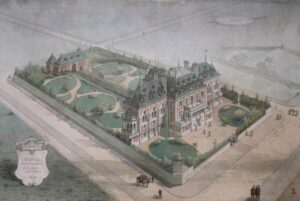Sanson, Paul Ernest (French / 1836-1918)
Paul Ernest Sanson was a French architect trained in the Beaux-Arts manner. Sanson entered the École des Beaux-Arts de Paris at the age of eighteen, and followed the courses offered by Émile Gilbert. Having received his diploma in 1861, he apprenticed first in the office of Denis-Louis Destors and Charles-Auguste Questel and then with Antoine-Nicolas Bailly, who passed his practice to Sanson when he retired in 1865. Sanson quickly made a grand reputation among aristocrats and the rich haute bourgeoisie for his châteaux and grand Parisian town houses, or hôtels particuliers. He took into his practice his son Maurice Pierre (1864–1913), Victor-Guillaume Bariller and René Sergent. The firm's offices were successively at 43, rue de Saint-Pétersbourg, 48, rue d'Anjou and 25, rue de Lubeck, Paris.
Sanson distinguished himself with his tasteful residences in the grand manner, which combined the great architectural tradition of French design of Mansart and Gabriel, with modern amenities of plumbing, heating, and the discreet separation of owners and guests from the supporting staff. He outclassed his rivals in the field by his deft manipulation of classical architectural vocabulary, and the sureness of his taste during an age characterised by architectural excess. In 1884, Sanson received the grande médaille d'argent for residential architecture bestowed by the Société centrale des architectes; it was followed in 1908, by the Société's grande médaille d'or. In 1911, he was received a chevalier of the Légion d'honneur.
Showing the single result
